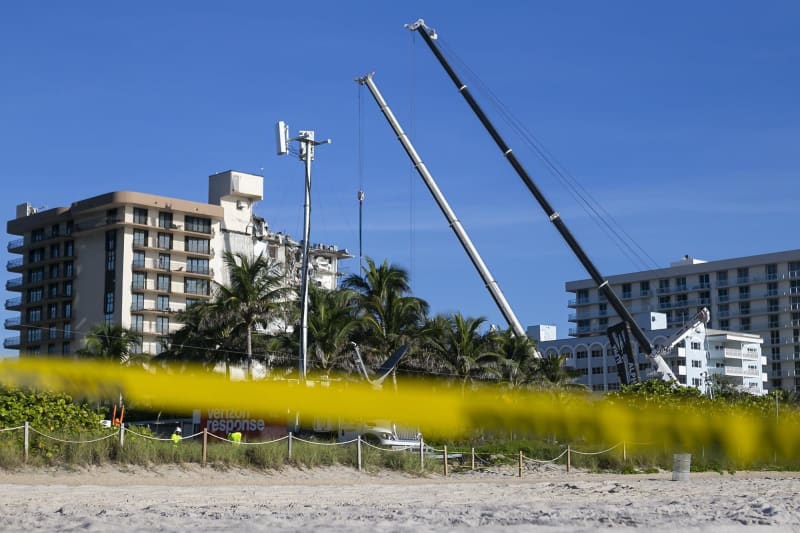Engineer’s insurers argue they shouldn’t be on hook for millions in Surfside condo collapse
2021/11/3
© Miami Herald

Rescue workers continue to look through rubble for survivors at the partially collapsed Champlain Towers South Condo building in Surfside, Florida, on July 3, 2021. - Matias J. Ocner/Miami Herald/TNS
MIAMI — Soon after the deadly collapse of a Surfside condo tower, dozens of victims and their relatives started filing lawsuits accusing the building’s condo association and its engineering consultant of causing the tragedy because they failed to keep the oceanfront structure safe.
Now two major insurance companies are using that same argument to deny huge coverage claims by Morabito Consultants, which was hired by the Champlain Towers South condo association to inspect the 12-story building and come up with a structural renovation plan long before it partially fell down in June.
To support their refusal to provide potentially tens of millions of dollars in coverage, the two insurers have sued Morabito and cited allegations in lawsuits filed by the very people hoping to collect on that insurance. The insurers’ suits argue the Champlain tower deaths and property losses were caused by the consulting firm’s “negligence,” including “acts or omissions in connection” with providing “professional engineering services.”
In response, Morabito Consultants have sued National Fire Insurance Company of Hartford and Continental Casualty Company, claiming that they did provide professional services, completed a 2018 structural safety report and produced a restoration plan that was just getting under way before the Champlain tower partially collapsed.
With limited funds to divide among the 98 people who died and the 136 owners who lost their units, the escalating dispute over the consultant’s insurance coverage could make a substantial difference in how much money the victims of Champlain Towers South can collect in damages from the June building collapse.
Both the victims and their lawyers involved in individual and class-action cases are closely following the legal battle between Morabito Consultants and its insurers, National Fire Insurance Company of Hartford and Continental Casualty Company. Both insurers have not only rejected Morabito’s insurance claims but also those of the Champlain Towers South condo association, which was covered under the engineering firm’s policy too.
The two insurers’ refusal to honor their policies with the Champlain condo association under Morabito’s coverage stands in stark contrast to several other insurance companies that have already agreed to pay in full the association’s property damage and personal injury claims, totaling about $50 million.
A spokesman for Morabito Consultants, Brett Marcy, blasted the two insurers for denying the claims. The engineering company “believes all relevant and necessary parties should be included in any litigation related to insurance coverage,” he said. “That includes the condo association and those parties representing the victims.”
The leaders of a team of lawyers in the Champlain class-action case, though adversaries of Morabito and the condo association, agreed with that approach.
“Insurance proceeds are critical to compensate the victims of this tragedy,” said Miami attorneys Harley Tropin and Rachel Furst, who are among the team of lawyers heading the class-action case against the Champlain condo association. “The insurance companies that insured those that played a role in causing the collapse have an obligation to honor their commitment and to provide coverage.”
Miami attorney Stephen Binhak, who represents developers with condo- and construction-related matters but is not involved in the Champlain cases, said that while the collapse of the Surfside high-rise is an extraordinary situation, the legal fight between the tower’s engineering consultant and its insurers is commonplace. Sharp differences arise not only over insurance coverage and “exclusion” provisions, but also over the amount of the payouts based on liability, caps on damages and other factors — including the number of accidents. In the Surfside case, for example, the building partially collapsed on the night of June 24 and the remaining structure was later demolished for safety reasons.
“Litigation over insurance coverage and claims is normal — you see it all the time,” Binhak said. ”Initially, there is the question of whether a policy covers a claim. If so, there is the question of how much insurance is ultimately available. Larger claims increase the chances of a lawsuit — especially when the damage may exceed the policy limits.
“After the World Trade Center collapse in 2001, with billions of dollars of insurance on the line, there was a lawsuit to determine whether the attack on the towers was a single ‘occurrence’ or two separate ‘occurrences’ for the purposes of insurance coverage,” Binhak he said. “Even with that level of insurance in place, the federal government stepped in to make funds available to compensate victims,” referring to the massive litigation that followed the 9/11 terrorist attacks on the twin north and south World Trade Center towers.
Morabito, a Maryland-based firm, was hired in 2018 by the Champlain Towers South condo association to provide a structural safety inspection and renovation plan for the 40-year “recertification” of the 8777 Collins Ave. property. Morabito found “major structural damage” to a concrete slab in the pool area and “abundant” deterioration of garage columns supporting the condo tower, but the association did not move forward on Morabito’s restoration plan until just before the building partially collapsed.
In the aftermath, Morabito Consultants was sued by its two insurance companies, National Fire Insurance Company of Hartford and Continental Casualty Company. The companies, known together as CNA, have denied Morabito’s insurance claims and also refused to defend the engineering consultant against 19 individual lawsuits brought by Champlain Towers South condo owners. Morabito is also expected to be sued in the ongoing class-action case representing most of the victims in the condo collapse.
In their lawsuit, the two insurance companies claim that the liability coverage provided under Morabito’s policy does not apply to bodily injury or property damage “caused by the rendering or failure to render any professional service.” CNA says the coverage, dealing only with Morabito’s engineering services, is excluded from its “primary” and “umbrella” insurance policies between 2017 and 2021. Also, the insurers denied coverage to the Champlain condo association, which was added to Morabito’s policies in recent years.
CNA’s lawyers, who filed the firm’s suit in Maryland federal court, did not return phone and email messages for comment.
Morabito Consultants fired back, filing a motion to dismiss CNA’s federal suit. The consulting firm’s lawyers argue among other things that the coverage matter belongs in the Miami-Dade Circuit Court where all of the parties affected by the Champlain tower collapse are fighting over liability and damage issues.
In fact, the engineering firm filed a lawsuit in Miami-Dade Circuit Court against its two insurance carriers as well as the Champlain condo association and the building’s individual owners who sued them. The reason: They all have an interest in Morabito’s coverage with CNA.
Morabito’s lawyers assert the insurance companies have no legal basis for denying the consulting firm’s claims for property losses and deaths in the condo collapse. They argue the firm’s engineers performed their “professional services” for the Champlain condo association and that its insurance coverage must be interpreted broadly not narrowly.
“CNA has ignored settled law governing the interpretation of insurance policies and the duty to defend and has wrongfully refused to defend Morabito against the [condo owners’] lawsuits,” Morabito’s suit says.
“Moreover, any allegations that could be construed to assert a failure to perform inspection or engineering services are contradicted by allegations that acknowledge Morabito properly performed inspection and engineering services and identified and reported serious structural issues to the [condo] association,” the suit says.
The Champlain condo building, completed in 1981, was facing a formal structural, mechanical and electrical review, as required under Miami-Dade’s building code nearly 40 years later. Morabito Consultants was hired by the condo board in 2018 and produced a nine-page inspection report, which was an initial summary of its structural findings. The estimated initial cost of repairs was heavy — $9 million — a price tag that caused dissension among board members and rose significantly to $15 million as the association delayed the repairs for almost three years. Morabito was also retained to prepare and oversee the restoration plan, which got under way starting with the replacement of the Champlain tower’s roof just before the collapse in June.
Although Morabito’s initial report did not raise an obvious red flag that the building was “unsafe” or at risk of falling down, the firm did urge Champlain’s condo board to replace and repair the deteriorating structural areas in the pool and garage areas in a “timely fashion” because the concrete problems could “expand exponentially.”
Under Miami-Dade County’s building code, “a building, or part thereof, shall be presumed to be unsafe if ... there is a deterioration of the structure or structural parts.” The ordinance further states that “the [local] Building Official, on his own initiative or as a result of reports by others, shall examine or cause to be examined every building or structure appearing or reported to be unsafe.”
But after Surfside’s building official was sent Morabito’s engineering report by a Champlain condo association member, the official met with the board after reviewing the document and assured members that “it appears the building is in very good shape,” according to minutes of a Nov. 15, 2018, board meeting.
Several structural engineers, after evaluating public records, condo plans and video footage of the collapse, told the Herald that they suspect the Surfside tower began to fall after the pool deck caved into the parking garage, which in turn undermined the structural integrity of the tower and triggered the collapse of the middle and oceanfront sections of the building. However, the exact cause of the collapse, under investigation by local and federal authorities, is still not known.
In the months after the tragedy, Miami-Dade Circuit Judge Michael Hanzman has tried to steer the litigation in the direction of recovering and raising as much money as possible to compensate the hundreds of victims — including condo owners and those who died. So far, with the help of receiver Michael Goldberg, who has taken over the Champlain condo association’s role, the judge has managed to recover $30 million in property coverage and $19 million in personal injury coverage from the association’s various insurance carriers — all of whom immediately agreed to honor their maximum policy coverage, unlike CNA, which refuses to pay out anything.
In addition, the now-vacant, nearly two-acre Surfside property fetched an initial bid from a private developer of $120 million. Higher bids could be offered for the lot, where there are plans for a luxury condo high-rise.
But dividing up those funds has been difficult because of the tragic ordeal. Hanzman assigned a mediator to figure out how to compensate both the Champlain condo owners and those who died in the collapse. But the mediator, lawyer Bruce Greer, said he has been unable to bridge the gap, with some condo owners saying they should receive all the money and the families of deceased residents saying all the funds should go to them.
Whatever money might be recovered from third parties, such as Morabito’s insurance carrier, CNA, would be added to the total pot of compensation.
“There is a heavy divide between the two sides,” said Martin Langesfeld, whose sister, Nicole, and her husband, Luis Sadovnic, died in a Champlain condo unit owned by Langesfeld’s grandparents. “They think we deserve nothing when we think we deserve everything.”
 E
E xcavators are seen working in the rubble of the Champlain Towers South collapse, one day after a shift from search-and-rescue to recovery in Surfside, Florida, on July 8, 2021. - Pedro Portal/Miami Herald/TNS


 E
E









/cdn.vox-cdn.com/uploads/chorus_image/image/70084721/acastro_210512_1777_deepfake_0002.0.jpg)


